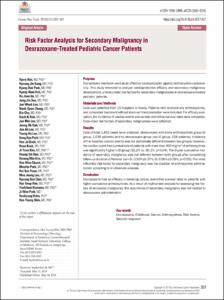Risk Factor Analysis for Secondary Malignancy in Dexrazoxane-Treated Pediatric Cancer Patients
- Keimyung Author(s)
- Kim, Ji Yoon; Kim, Heung Sik
- Department
- Dept. of Pediatrics (소아청소년학)
- Journal Title
- Cancer Research and Treatment
- Issued Date
- 2019
- Volume
- 51
- Issue
- 1
- Keyword
- Dexrazoxane; Childhood; Cancer; Anthracyclines; Risk factors; Second neoplasm
- Abstract
- Purpose
Dexrazoxane has been used as an effective cardioprotector against anthracycline cardiotoxicity. This study intended to analyze cardioprotective efficacy and secondary malignancy development, and elucidate risk factors for secondary malignancies in dexrazoxane-treated pediatric patients.
Materials and Methods
Data was collected from 15 hospitals in Korea. Patients who received any anthracyclines, and completed treatment without stem cell transplantation were included. For efficacy evaluation, the incidence of cardiac events and cardiac event-free survival rates were compared. Data about risk factors of secondary malignancies were collected.
Results
Data of total 1,453 cases were analyzed; dexrazoxane with every anthracyclines group (D group, 1,035 patients) and no dexrazoxane group (non-D group, 418 patients). Incidence of the reported cardiac events was not statistically different between two groups; however, the cardiac event-free survival rate of patients with more than 400 mg/m2 of anthracyclines was significantly higher in D group (91.2% vs. 80.1%, p=0.04). The 6-year cumulative incidence of secondary malignancy was not different between both groups after considering follow-up duration difference (non-D, 0.52%±0.37%; D, 0.60%±0.28%; p=0.55). The most influential risk factor for secondary malignancy was the duration of anthracycline administration according to multivariate analysis.
Conclusion
Dexrazoxane had an efficacy in lowering cardiac event-free survival rates in patients with higher cumulative anthracyclines. As a result of multivariate analysis for assessing risk factors of secondary malignancy, the occurrence of secondary malignancy was not related to dexrazoxane administration.
- Publisher
- School of Medicine (의과대학)
- Citation
- Hyery Kim et al. (2019). Risk Factor Analysis for Secondary Malignancy in Dexrazoxane-Treated Pediatric Cancer Patients. Cancer Research and Treatment, 51(1), 357–367. doi: 10.4143/crt.2017.457
- Type
- Article
- ISSN
- 2005-9256
- Source
- https://www.e-crt.org/journal/view.php?doi=10.4143/crt.2017.457
- Appears in Collections:
- 1. School of Medicine (의과대학) > Dept. of Pediatrics (소아청소년학)
- 파일 목록
-
-
Download
 oak-2019-0008.pdf
기타 데이터 / 659.25 kB / Adobe PDF
oak-2019-0008.pdf
기타 데이터 / 659.25 kB / Adobe PDF
-
Items in Repository are protected by copyright, with all rights reserved, unless otherwise indicated.